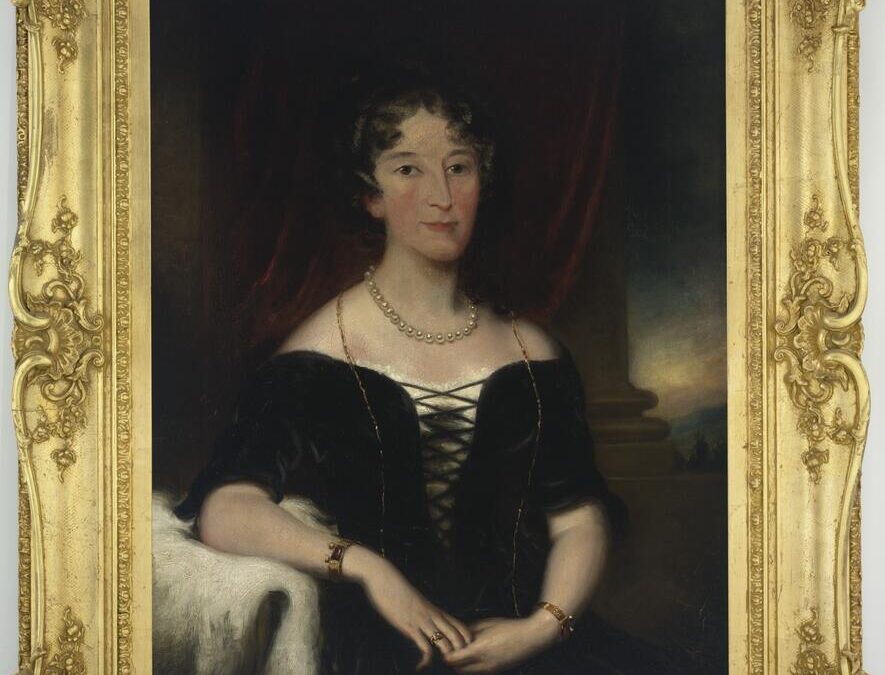by Bill Holloway
 Elizabeth Macarthur (1766-1850), who came out on the Second Fleet in 1790 with her husband John, a lieutenant in the New South Wales Corps, was maybe the first (white) woman – first of many, of course – to be written out of her rightful place in Australian history.
Elizabeth Macarthur (1766-1850), who came out on the Second Fleet in 1790 with her husband John, a lieutenant in the New South Wales Corps, was maybe the first (white) woman – first of many, of course – to be written out of her rightful place in Australian history.
Elizabeth Macarthur has been a favourite subject for reevaluating/reimagining over the last few years. First, Michelle Scott Tucker’s biography, Elizabeth Macarthur: A Life at the Edge of the World (2018); then Sue Williams’ Elizabeth & Elizabeth (2021); Kate Grenville’s A Room Made of Leaves (2021); and also Kate Grenville (ed.) Elizabeth Macarthur’s Letters (2022) – which Grenville characterises as “weaponised irony”, perhaps to justify her own fiction.
 The reason for this is that she’s such an interesting character, lost for two centuries behind the accepted view, which we all learnt at school, that John Macarthur single-handedly founded the Australian wool industry.
The reason for this is that she’s such an interesting character, lost for two centuries behind the accepted view, which we all learnt at school, that John Macarthur single-handedly founded the Australian wool industry.
I wrote last month that the dominant paradigm for Australianness is the Lone Hand – the man and his mates who are masters of the Bush. It is a ridiculous paradigm in such a suburban nation, yet it motivates so many of us, truck drivers and grey nomads alike, to ‘find ourselves’ in the Outback.
The obverse of the Lone Hand (and of his mate, the Brave Anzac) is that it was women who were left to manage not just the home, but the industry which maintains the home. Their lives were rarely told, but Henry Lawson’s The Drover’s Wife is a version of the story he and his sister Gertrude heard over and over from their mother Louisa, of the countless times she had to manage on her own, manage the house, manage the farm, manage the local post office while their father Peter Larsen was away prospecting, droving, shearing.
Up until the 1850s, so for the first 60 odd years of white settlement, the only writing was letters and diaries, reports to ministers in London, and newspaper accounts carried in British and local papers. There were no paradigms being explored or developed in fiction, excepting I guess, Quintus Serviton (1831) which played to British prejudices about a convict population in a hostile Bush. If two of our earliest novels, Clara Morison (1854) by CH Spence and Gertrude the Emigrant (1857) by Louisa Atkinson, were about women managing without men, then this was soon conveniently forgotten.
The principal women of the early days of the colony, for the purposes of establishing the legend of the Independent Woman, were:
Mary Bryant – a convict on the First Fleet, who led a party consisting of her husband, her young children, and seven other convicts to escape from Port Jackson in 1791 in an open boat, emulating Bligh’s similar amazing voyage two years earlier, 5,000 kms up the east coast and around the north to Timor;
Mary Reibey – who arrived in Sydney as a convict in 1790; married Thomas Reibey, a trader; had seven children; then as they prospered, managed the family interests for long periods while Thomas was overseas, until in 1811, he died and she become sole proprietor, rising to “respectability and affluence in the new emancipist society” (ADB), a “legendary” businesswoman until her death in 1855. (see also: Grantlee Kieza, The Remarkable Mrs Reibey)
Elizabeth Macarthur – who, like Reibey, had sole management of the family’s business interests for years at a time, but unlike Reibey, whose enterprise went unnoticed.
The Macarthur story is well known (to Australians). The initial farm, Elizabeth Farm, on the river at Parramatta (20 km up river from Sydney Harbour). The land grants at Cow Pastures, 20 or 30 km further out, which eventually became Camden Park. The importing of merino sheep, from South Africa and from the King’s flock in England. John’s two long absences in London (1801-05 and 1809-17), the first for a court martial and the second after he, now a civilian, led a rebellion against Governor Bligh. The slow growth of the fine wool industry to serve the mills of England and the Industrial Revolution.
In her biography of Elizabeth, Scott Tucker slowly and surely builds a lawyerly case for John’s fecklessness, right from the beginning. The rushed marriage, his constant disputes with his fellow officers, duels, risky business decisions, grandiose plans for the future. As he gets older he complains of frequent debilitating bouts of depression, interestingly recognised as illness by both the sufferer and Elizabeth, eventually interspersed with bursts of mania until we, and his family, recognise that he is out of control, in modern terms is bi-polar, and his sons become his guardians.
So, from 1801 to 1817 it is Elizabeth who manages and grows the family business. John and later their older sons are valuable envoys in London, but they must be supported in style and Elizabeth must manage the flocks, the horses, the home farm and orchards, the large numbers of convict servants and farm workers, keep the accounts. Above all she must improve the quality of the wool and get it off to England. .
Scott Tucker maintains a proper emphasis throughout her account on the Eora people who were displaced by the colonists. Early relations were friendly, but as the original inhabitants, and particularly the Gandagarra from the mountains enclosing the Sydney basin, began to fight back, Elizabeth’s attitudes hardened and she went along with the retributive raids by government forces which culminated in the 1816 Appin massacre.
After his return in 1817, John became increasingly incapable of dealing with his illness. He demanded, in 1831, that Elizabeth leave him. In 1833 the family confined him to Camden Park and Elizabeth, who had been living away from the family properties with other members of her extended family, was able “to return to dear home” at Elizabeth Farm. John died in April 1834, and Elizabeth, without ever carrying out her oft expressed wish to return home to England, to Bridgerule, in February 1850.
.
Michelle Scott Tucker
Elizabeth Macarthur: A Life at the Edge of the World
Text, Melbourne, 2018
999 pp
Kerrie Davies, ‘Weaponised irony’: after fictionalising Elizabeth Macarthur’s life, Kate Grenville edits her letters,The Conversation, April 14, 2022
Portrait from State Library NSW
“Elizabeth Macarthur, undated
Unknown artist
oil on canvas
presented by Sir William Dixson, 1935″






I loved learning about Elizabeth when writing “The Lockleys of Parramatta” series.
She’s very much a minor character, but there are many of our Early women who have been overlooked.
Hopefully my granddaughters (and great granddaughter) will grow up reading histories, and historical fiction, in which women are given credit for the work they did, as well as for the possibilities which they were denied.
I’ve written a stack ( 24 so far) of stories about this era. Most have strong female leads, inspired my our own convicts (we have seven between us, 4 women and 3 men) Some would have known Elizabeth well as they had the government Stores in Parramatta. Our colonial women, both convict and free were incredible. They were taken from the English streets, dumped into a foreign land, and expected to make the most of it.
To add to your list, eminent historian Alan Atkinson’s dual biography ‘Elizabeth and John’ was published in 2022, to much acclaim. Clearly EM is having a moment!
And to add to your point about women being overlooked: that portrait of ‘Elizabeth Macarthur’ you’ve included is probably not her… Despite the fact that the SLNSW says it is, the provenance is dubious, at best. What IS known is that it was painted in London, a city to which EM never returned, so even if it was commissioned by the family (no evidence) it must have been copied from an Australian image – possibly a miniature – that the family sent over.
Grateful to you for featuring EM – she’ll always have a place in my heart, lol.
Elizabeth deserves her time in the sun, as your biography makes clear. Next week we are running a review of Eleanor Dark’s The Timeless Land trilogy, which features John in the second book, and barely mentions Elizabeth as far as I can see.
I suppose it’s possible that in the years John and the boys were in London one of them commissioned a portrait of their wife/mother. Interesting that the provenance is so doubtful.
Sounds like a fascinating figure for sure.
I’ve not thought much about the wool industry. But as I have been reading a little fiction from Iceland lately, I have been spending more time with sheep on the page.
If Iceland has sheep why doesn’t Canada? At the height of the wool boom (during the Korean War) we had them well into the tropics and way out in the deserts; I’m sure they would have preferred snow.
A more relevant question: did Canadian second generation feminists set about recovering forgotten/ignored women?